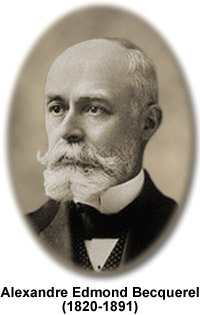Alexandre Edmond Becquerel
(1820-1891)

Four successive generations of the Becquerel family were educated at the prestigious French scientific institution of higher learning, the École Polytechnique, and became physics professors at the French Museum of Natural History. Alexandre Edmond Becquerel was the son of Antoine César (1788-1878), discoverer of piezoelectricity, father of Antoine Henri (1852-1908), who discovered radioactivity, and the grandfather of Jean Antoine (1878-1953), who is best known for his work on relativity and the discovery of polarization rotation in the presence of a magnetic field. Though all of these notable scientists carried out a variety of experiments related to optics, it was Alexandre Edmond Becquerel that made the greatest contributions to the field.
Born in Paris on March 24, 1820, Alexandre Edmond Becquerel became first a student, and then an assistant, to his father, and many of his investigations are associated with those of the elder Becquerel. Edmond was, however, particularly intrigued by light and embarked on in-depth studies of the subject. He examined the spectroscopic characteristics and the photochemical effects of the sun, and was especially interested in the phenomena of fluorescence and phosphorescence. To aid in his study of the latter, Becquerel invented the phosphoroscope, a device capable of measuring the duration of time between the exposure of a solid, liquid, or gas to a light source and the substance’s exhibition of phosphorescence. Through the use of the phosphoroscope, the physicist was able to more accurately determine whether or not certain materials exhibited phosphorescence or fluorescence, since one of the key differences between the phenomena is the duration of the excited state lifetime, which is the interval of time that passes before the effect occurs following the absorption of light (fluorescence occurs almost instantaneously after excitation, whereas phosphorescence is characterized by a much longer excited state lifetime). The phosphoroscope also enabled Becquerel to discover phosphorescence in a number of materials that were previously not believed to exhibit the effect.
Alexandre Edmond Becquerel’s work with fluorescence and phosphorescence led him in the late 1850s to develop the idea of utilizing these effects in light sources. He experimentally applied various luminescent materials as coatings to electric discharge tubes, and though he never succeeded in producing a commercial light, his work eventually led to the development of the fluorescent lamps that are widely used in modern times. Findings from many of Becquerel’s studies of luminescence and other areas of optics were published in 1867 and 1868 in the two-volume treatise entitled La Lumiere, ses causes et ses effets. His appointment at the Museum of Natural History occurred in 1878, so that he directly succeeded his well-known father, and he was a member of the Académie des Sciences from 1863 to his death on May 11, 1891.
